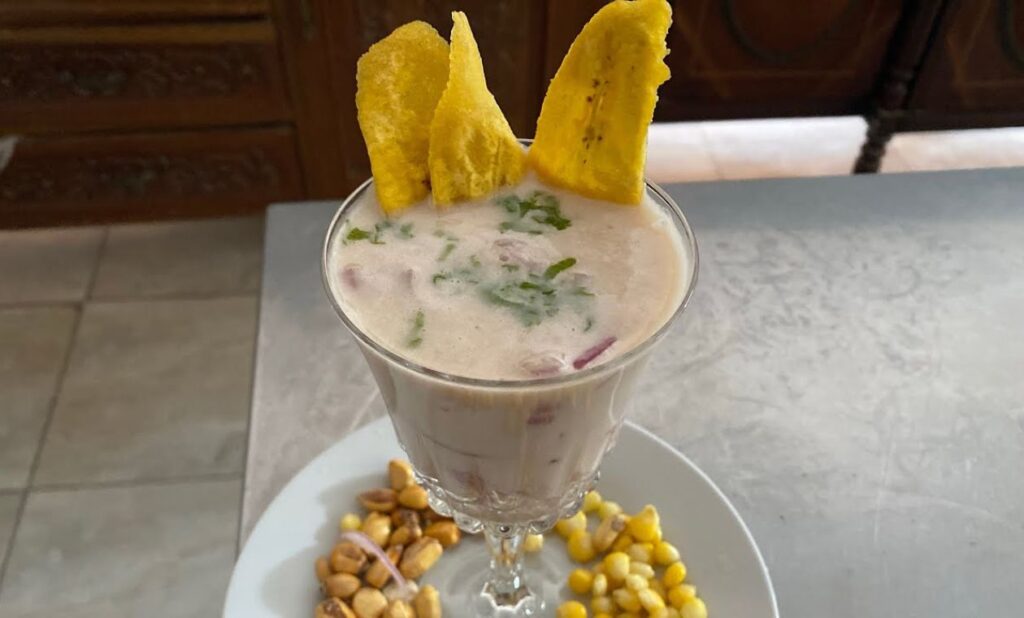Leche de Tigre: Origins, Recipe, and Health Benefits

Leche de Tigre, translating to “tiger’s milk,” is a vibrant marinade deeply rooted in Peruvian culinary heritage. This zesty concoction is a cornerstone of Peruvian cuisine, particularly renowned for its role in ceviche. While its origins remain shrouded in mystery, historical theories suggest a blend of cultural influences, possibly dating back to pre-Columbian times. The name “leche de tigre” itself sparks curiosity, with various interpretations circulating. Some speculate its potency akin to a tiger’s strength, while others suggest a resemblance to the milky texture of the marinade. Regardless of its enigmatic name, leche de tigre holds a special place in Peruvian gastronomy, symbolizing the fusion of tradition and innovation.
Also Read: Fancy Ice Cubes Guide
Ingredients
- Lime Juice: Lime juice serves as the backbone of leche de tigre, imparting its signature acidity and bright zestiness. This citrusy component not only enhances flavor but also aids in the “cooking” process of raw seafood, contributing to the ceviche’s delicate texture.
- Fish or Shellfish Stock: Fish or shellfish stock adds depth and complexity to leche de tigre, elevating its flavor profile. This savory element provides a umami-rich base that harmonizes with the tanginess of lime juice, creating a well-balanced marinade.
- Aji Limo Peppers: Aji limo peppers are the fiery heart of leche de tigre, infusing it with heat and spice. These Peruvian chilies contribute a distinctive kick, adding depth and complexity to the marinade’s flavor profile.
- Aromatics: Aromatics such as onion, cilantro, and garlic play a crucial role in imparting savory notes to leche de tigre. These ingredients enhance the overall aroma and taste, creating a well-rounded marinade that tantalizes the senses.
- Spices: Spices like salt, pepper, and other seasonings are essential for adding additional layers of flavor to leche de tigre. These spices complement the other ingredients, enhancing the marinade’s taste and complexity.
By carefully balancing these core ingredients, leche de tigre achieves its distinctive flavor profile, making it a versatile and indispensable element in Peruvian cuisine.
Preparation
- To craft the perfect leche de tigre, start by blending all the ingredients together in a blender. This process ensures that the flavors meld together seamlessly, resulting in a smooth and cohesive marinade.
- After blending, strain the mixture through a fine-mesh sieve to remove any coarse bits or impurities. This step is essential for achieving a silky texture, ensuring that the marinade coats the seafood evenly and imparts its full flavor.
- Once strained, pour the leche de tigre over raw seafood, such as fish or shellfish, and allow it to marinate for a few minutes. The acidity of the marinade “cooks” the seafood, resulting in a tender and flavorful dish that’s bursting with freshness.
By following these traditional preparation steps, you’ll be able to create leche de tigre that’s not only delicious but also true to its Peruvian roots.
Versatile Uses Beyond Ceviche
Cooking:
Leche de tigre goes beyond its traditional role in ceviche; its acidity can “cook” raw seafood, similar to heat cooking. This technique tenderizes the seafood while infusing it with a burst of citrus flavor. Additionally, leche de tigre can be used to marinate meats, such as tuna or chicken, tenderizing them and imparting a delicious flavor for salads or stir-fries.
Flavor Booster:
The vibrant flavors of leche de tigre make it a versatile ingredient for enhancing various dishes. It can be used to add a citrusy and spicy kick to soups, such as Chupe de Langostinos (shrimp chowder), providing a refreshing and aromatic base. Similarly, diluted or blended with additional ingredients, leche de tigre creates tantalizing sauces for vegetables, zesty dips for chips, or tangy dressings for salads, elevating the overall flavor profile of the dish.
Health Benefits:
Beyond its culinary uses, leche de tigre is believed to offer potential health benefits. The enzymes from fish stock and the acidity of lime juice may aid digestion, particularly when enjoyed with seafood. Additionally, leche de tigre is a good source of vitamin C from lime juice, essential for immune function. While these health claims should be approached with caution and further research is needed, incorporating leche de tigre into your diet as part of a balanced and varied meal plan may offer digestive support and contribute to overall well-being.
Also Read: Miami Vice Cocktail
Variations and Adaptations
Spicy, Creamy, Fruity, and Herb-Infused Variations:
- Leche de tigre lends itself well to experimentation, allowing for a myriad of variations to suit different tastes and preferences.
- For those seeking an extra kick, additional aji limo peppers or other spicy chilies can be incorporated into the marinade, enhancing its heat level.
- To create a creamier texture, some versions of leche de tigre include ingredients like fish roe, milk, or cream, adding richness and depth to the marinade.
- For a fruity twist, fruits such as passion fruit or mango can be added to leche de tigre, providing a sweet and tangy flavor that complements the citrusy notes of the marinade.
- Herb-infused variations of leche de tigre offer a fresh and aromatic dimension to the marinade. Ingredients like culantro or ginger can be used to infuse unique flavors, adding complexity to the dish.
Examples of Dishes Incorporating Leche de Tigre:
- Tiro de Leche: A creamy and cold seafood soup that typically features leche de tigre as a key ingredient, offering a refreshing and flavorful starter.
- Causa Rellena: A traditional Peruvian dish made with mashed potatoes and various fillings, including options marinated in leche de tigre-infused seafood, providing a vibrant and tangy twist.
- Arroz con Mariscos: A flavorful rice dish cooked with seafood, often seasoned with leche de tigre for added zest and acidity, creating a harmonious blend of flavors.
- Nikkei Cuisine: Fusion Peruvian-Japanese cuisine incorporates leche de tigre in creative ways, such as ceviche rolls or sushi dressings, showcasing its versatility and adaptability across different culinary traditions.
Potential Health Benefits and Considerations
Vitamin C and Mineral Content:
Leche de tigre offers a significant dose of vitamin C from lime juice, an essential nutrient known for its role in immune function and collagen production. Additionally, fish stock contributes minerals like potassium and iron, which are important for various bodily functions.
Digestive Aid and Immune System Boost:
The enzymes present in fish stock, combined with the acidity of lime juice, may act as digestive aids, particularly when consumed with seafood. This digestive support can contribute to overall gut health and comfort. Furthermore, the vitamin C content in leche de tigre may also provide a boost to the immune system, supporting the body’s defense against infections and illnesses.
Cautionary Notes on Sodium Content and Raw Seafood Consumption:
It’s important to be mindful of the sodium content in leche de tigre, which can vary depending on the recipe and type of fish stock used. Individuals with concerns about sodium intake should exercise moderation when consuming dishes prepared with leche de tigre.
Additionally, while leche de tigre is primarily used to marinate raw seafood, it’s crucial to ensure that the seafood is fresh and properly handled to minimize the risk of foodborne illnesses. Proper refrigeration and hygiene practices should be followed when preparing dishes with raw seafood and leche de tigre.
By considering these health benefits and precautions, individuals can incorporate leche de tigre into their diet as part of a balanced and nutritious eating plan, enjoying its flavorful and potentially beneficial properties while minimizing potential risks.
Leche de Tigre’s History
Theories on Its Pre-Columbian Origins:
While the exact origins of leche de tigre are shrouded in mystery, several theories suggest a connection to pre-Columbian times. It’s believed that the marinade may have been influenced by indigenous culinary practices, possibly dating back to ancient civilizations in the Andean region. However, due to the lack of concrete historical evidence, the true origin of leche de tigre remains a subject of speculation and debate.
Evolution and Modern Reinvention:
Over the centuries, leche de tigre has evolved and adapted, reflecting the cultural influences and culinary innovations of Peru. From its humble beginnings as a simple marinade for ceviche, it has undergone various transformations, incorporating new ingredients, flavors, and techniques. Today, chefs worldwide are reimagining leche de tigre, infusing it with modern twists and creative interpretations, while still honoring its traditional roots. This ongoing evolution highlights the dynamic nature of Peruvian cuisine and the enduring legacy of leche de tigre.
Where to Find and Experience Authentic Leche de Tigre:
Authentic leche de tigre can be found and experienced in various settings, ranging from traditional Peruvian markets and restaurants to international specialty stores and innovative culinary establishments. In Peru, it’s readily available in grocery stores and eateries specializing in ceviche and other seafood dishes. Additionally, international food markets and online retailers may offer access to high-quality leche de tigre ingredients for home cooks eager to explore Peruvian cuisine. Whether savoring it in its place of origin or experimenting with homemade versions, discovering authentic leche de tigre offers a delightful journey into the rich tapestry of Peruvian gastronomy.
Also Read: Licor 43 Cocktails
In Crux
In conclusion, leche de tigre stands as a testament to the rich culinary heritage of Peru, embodying both versatility and cultural significance. From its origins shrouded in mystery to its modern reinvention, leche de tigre continues to captivate palates worldwide with its vibrant flavors and potential health benefits.
As we’ve explored, leche de tigre transcends its traditional role in ceviche, finding its way into an array of dishes, from soups to sauces, and even cocktails. Its tangy acidity and complex flavor profile make it a versatile ingredient that adds depth and zest to any culinary creation.
We encourage you to embark on your own culinary adventure and explore the wonders of leche de tigre. Whether you’re savoring it in a traditional Peruvian dish or experimenting with innovative recipes at home, let leche de tigre be your guide to a world of flavor and culture.

Chef Carlos Jackson, the culinary virtuoso behind the vibrant flavors at Taste Recipe. With a rich tapestry of experiences spanning 17 years across top-tier international hotels in Miami, Australia, Dubai, and the USA, Carlos has mastered the art of blending cultures on a plate. His expertise isn’t just limited to the realms of Thai, Continental, Italian, and Chinese cuisines; it’s his unparalleled passion for bar culture that sets him apart. Carlos’s journey from global kitchens to your screens is driven by a desire to share not just recipes, but stories woven with love, taste, and tradition. At Taste Recipe, he pours his heart into every dish, inviting you to explore a world where flavors know no boundaries. Join him as he turns simple ingredients into culinary masterpieces, building a community of food lovers who value experience, expertise, authority, and trustworthiness. Welcome to a world curated by Chef Carlos, where every recipe is a journey.





